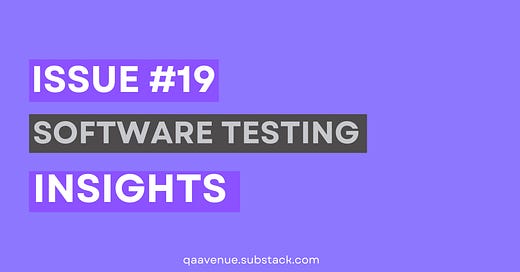Welcome to the 19th edition of QA Avenue ✨. As the leading community for QA professionals, we bring you the must-read content that drives excellence in the field. Hope you're having a fantastic week!
This time, we will explore:
Shift E2E Testing Left: Uber's Approach
Scaling Microservice Testing Beyond Staging
Master Equivalence Partitioning for Better Testing
Align Developers & Testers for Quality
Integrate Test Results in GitHub Actions
And many more....
📚 News
Shifting E2E Testing Left at Uber
Quess Liu and Daniel Tsui discuss how Uber has shifted its E2E testing left, integrating it earlier in the development process to catch issues sooner and improve software quality across the board.
Why Staging Doesn’t Scale for Microservice Testing
Arjun Iyer highlights the limitations of staging environments for microservice testing and introduces the concept of safe sharing as a scalable solution to overcome these challenges, improving efficiency for development teams.
Equivalence Partitioning Explained: A Practical Guide for Testers
Bahadir Kucukuysal shows a practical guide to Equivalence Partitioning, breaking down this essential testing technique to help testers efficiently manage test cases and improve test coverage.
How Developers and Testers Can Align on Testing Goals
Irfan Mujagic highlights how developers and testers working together deliver higher-quality software with fewer bugs and a smoother process—teamwork that turns good software into great software.
GitHub Actions PR Comment With Test Results
Matthew Thomas demonstrates how to use the `github-actions-ctrf` package to showcase test results directly within GitHub workflows, simplifying the process of assessing test outcomes without digging through console logs.
🧑🏻💻 Automation
Detecting Process Death issues with Maestro
Alexander Gherschon shows how to use Maestro to detect System-initiated Process Death issues. Follow his step-by-step guide to set up Maestro, write YAML scripts, and test app data persistence post-process death.
Pytest and PostgreSQL: Fresh database for every test
Libor Jelínek provides a step-by-step guide for automating database setup and teardown using Pytest fixtures. Learn how to configure fixtures and use Yoyo migrations for a consistent PostgreSQL database state in your tests.
How We Implemented a Robust CI/CD Pipeline for Our SaaS Product
Halil Ural shows how to implement a robust CI/CD pipeline for SaaS products, detailing essential steps and strategies for efficient deployment and development.
Enhancing Memory Leak Detection for Black Box QEs in iOS
Fran Roig introduces a custom tool for on-screen memory usage display, boosting memory leak detection for iOS black box testing. This tool offers real-time insights to swiftly identify and fix performance issues.
How Do I Combine Playwright HTML Reports After Running Multiple Playwright Commands?
Butch Mayhew shows how to combine Playwright test reports from separate runs using the "blob" reporter. His guide includes a step-by-step script to merge reports seamlessly.
Case Study: Use Selenium To Extract A List of Published Medium Article Titles
Courtney Zhan's guide reveals how to master Selenium with a practical use case: handling Medium's lazy loading to scroll, extract, and save article titles. Dive in for a detailed, step-by-step approach!
ML-Driven Test Automation with Open Source Tools
Vishwas Kumar explores how to leverage open-source tools for ML-driven test automation, showcasing methods to enhance testing efficiency and effectiveness through machine learning techniques.
📨 Submit Your Articles, Tutorials, and Tools!
💡 Have an idea you'd like to share? Click here to submit your ideas! 📝
For more updates, follow us on LinkedIn at QA Avenue.




